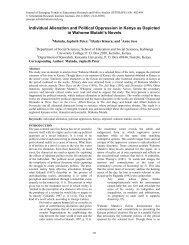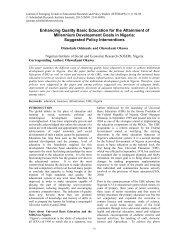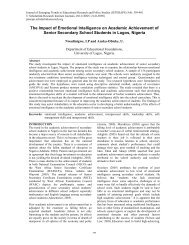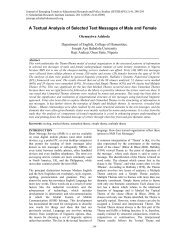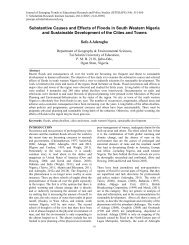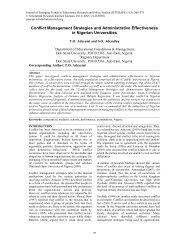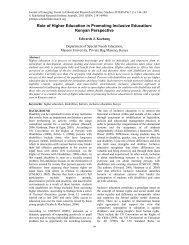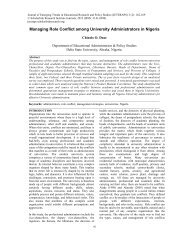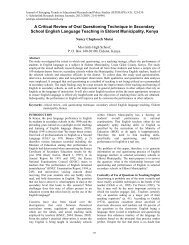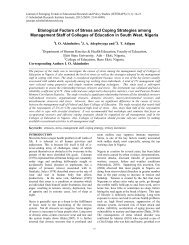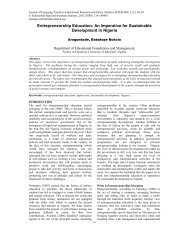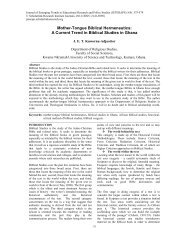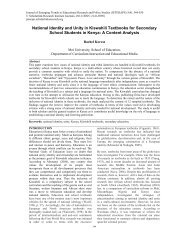School Principal's Leadership Style - Journal of Emerging Trends in ...
School Principal's Leadership Style - Journal of Emerging Trends in ...
School Principal's Leadership Style - Journal of Emerging Trends in ...
Create successful ePaper yourself
Turn your PDF publications into a flip-book with our unique Google optimized e-Paper software.
<strong>Journal</strong> <strong>of</strong> <strong>Emerg<strong>in</strong>g</strong> <strong>Trends</strong> <strong>in</strong> Educational Research and Policy Studies (JETERAPS) 3(4): 444-446<br />
<strong>Journal</strong> © Scholarl<strong>in</strong>k <strong>of</strong> <strong>Emerg<strong>in</strong>g</strong> Research <strong>Trends</strong> Institute <strong>in</strong> Educational <strong>Journal</strong>s, 2012 Research (ISSN: and 2141-6990) Policy Studies (JETERAPS) 3(4):444-446 (ISSN:2141-6990)<br />
jeteraps.scholarl<strong>in</strong>kresearch.org<br />
<strong>School</strong> Pr<strong>in</strong>cipal’s <strong>Leadership</strong> <strong>Style</strong>:<br />
A Factor Affect<strong>in</strong>g Staff Absenteeism <strong>in</strong> Secondary <strong>School</strong>s<br />
1 Ongeri Lucas, 2 Philip Kiprotich Bii, 3 Timothy Sulo, 2 Betty Keter<br />
2 Elias Maiyo Yano, and 3 Noah Koskey<br />
1 Kitale Technical Tra<strong>in</strong><strong>in</strong>g Institute,<br />
Maths and Applied Sciences Department, Box 2162 -30200 Kitale, Kenya.<br />
2 Moi University,<br />
Market<strong>in</strong>g and Management Science Department, Box 825 -30100 Eldoret, Kenya.<br />
3 Moi University,<br />
<strong>School</strong> <strong>of</strong> Bus<strong>in</strong>ess and Economics, Box 3900 -30100, Eldoret, Kenya.<br />
_________________________________________________________________________<br />
Abstract<br />
Teacher absenteeism is a persistent problem <strong>in</strong> many countries as it tends to reduce the quality <strong>of</strong> education and<br />
results <strong>in</strong> poor performance <strong>of</strong> students. The purpose <strong>of</strong> this study was to assess whether pr<strong>in</strong>cipal’s leadership<br />
style had a relationship with absenteeism among teachers <strong>in</strong> secondary schools <strong>in</strong> Bar<strong>in</strong>go County, Kenya. The<br />
objectives <strong>of</strong> the study were; to assess the effect <strong>of</strong> transformational leadership style on teacher absenteeism, and<br />
to establish the effect <strong>of</strong> transactional leadership style on teacher absenteeism. A survey research design was<br />
used for this study. The <strong>in</strong>stitutions studied were selected us<strong>in</strong>g stratified random sampl<strong>in</strong>g technique. The two<br />
strata considered were public and private secondary schools. A modified Multi-factor <strong>Leadership</strong> Questionnaire<br />
(MLQ) was used to determ<strong>in</strong>e leadership style <strong>of</strong> the pr<strong>in</strong>cipal. The leadership styles were identified as the<br />
<strong>in</strong>dependent variable, while absenteeism was the dependent variable. There was a significant negative l<strong>in</strong>ear<br />
relationship between transformational leadership style and absenteeism (R 2 =0.854, β=-0.927, t=13.283,<br />
F=176.4, and p=0.000), and a significant positive l<strong>in</strong>ear relationship between transactional leadership style and<br />
absenteeism (R 2 =0.665, β=0.823, t=7.790, F=60.70, and p=0.000). It was therefore concluded that pr<strong>in</strong>cipal’s<br />
leadership style <strong>in</strong>fluences absenteeism.<br />
__________________________________________________________________________________________<br />
Keywords: transformational, transactional, absenteeism, performance, leadership style, multi-factor leadership<br />
questionnaire.<br />
__________________________________________________________________________________________<br />
INTRODUCTION<br />
For decades bus<strong>in</strong>ess and <strong>in</strong>dustry have struggled<br />
with the problem <strong>of</strong> employee absenteeism, a fact<br />
that is supported by the vast body <strong>of</strong> literature that<br />
addresses the issue. In fact, absenteeism and staff<br />
turnover are the two most frequent outcomes studied<br />
<strong>in</strong> organizational research (Long & Ormsby, 2001).<br />
One <strong>of</strong> the key pillars <strong>of</strong> Vision 2030 <strong>in</strong> Kenya is<br />
provision <strong>of</strong> quality education. <strong>School</strong> systems have<br />
been engaged <strong>in</strong> a system <strong>of</strong> educational reform<br />
designed to change school culture and to improve<br />
student achievement. The f<strong>in</strong>ancial cost <strong>of</strong> teacher<br />
absenteeism is significant. Teacher absence <strong>of</strong>ten<br />
means that students have lost opportunities to learn.<br />
Further, teacher absences disrupt the rout<strong>in</strong>es and<br />
relationships which support the learn<strong>in</strong>g process<br />
(Miller, et al., 2007). While research has clearly<br />
demonstrated that teacher absence has a negative<br />
effect on student achievement (Ehrenberg et al.,<br />
1991; Clotfelter, 2007; Miller et al., 2007), the<br />
research has not been as demonstrative about the<br />
causes or predictors <strong>of</strong> teacher absence. Conflict<strong>in</strong>g<br />
evidence exists about the effects <strong>of</strong> characteristics<br />
such as gender, age, experience, time <strong>of</strong> week and<br />
school culture. For <strong>in</strong>stance, some studies have<br />
444<br />
shown that female teachers are absent more<br />
frequently than male teachers (Scott, 1990; Clotfelter,<br />
2007), while others have found that men are absent<br />
more frequently than women (Chaudhury, Hammer,<br />
Kremer, Muralidharan, & Rogers, 2006 and<br />
Rosenblatt & Shirom, 2005). The results <strong>of</strong> various<br />
studies appear to be contextual <strong>in</strong> nature, and<br />
therefore, are conclusive for the environs <strong>in</strong> which<br />
they were conducted. As a result, there was need to<br />
do a study <strong>of</strong> the teacher absence behaviors <strong>in</strong> the<br />
Kenyan context. Gupta (2003) called excessive<br />
absenteeism among school personnel one <strong>of</strong> the most<br />
neglected problems <strong>in</strong> public education. While<br />
teacher absenteeism is widely recognized as a serious<br />
problem, there is surpris<strong>in</strong>gly little systematic data as<br />
to the pervasiveness or extent <strong>of</strong> the problem <strong>in</strong><br />
Kenya. Consider<strong>in</strong>g current economic conditions <strong>in</strong><br />
our country, and the emphasis <strong>of</strong> us<strong>in</strong>g education to<br />
atta<strong>in</strong> the Vision 2030 goals, it is important that<br />
researchers be able to identify causes <strong>of</strong> teacher<br />
absenteeism <strong>in</strong> order to develop solutions to the<br />
problem. There is widespread consensus that teacher<br />
absenteeism is a major threat. This study delved <strong>in</strong>to<br />
study<strong>in</strong>g the headteacher’s leadership style as a factor<br />
that predisposes teacher absenteeism. Bar<strong>in</strong>go
<strong>Journal</strong> <strong>of</strong> <strong>Emerg<strong>in</strong>g</strong> <strong>Trends</strong> <strong>in</strong> Educational Research and Policy Studies (JETERAPS) 3(4):444-446 (ISSN:2141-6990)<br />
District is one <strong>of</strong> the hardest hit districts by<br />
absenteeism by secondary school teachers <strong>in</strong> Kenya<br />
(M<strong>in</strong>istry <strong>of</strong> Education, 2007).<br />
HYPOTHESIS<br />
This study was guided by the follow<strong>in</strong>g hypotheses:<br />
H 01 . There is no significant l<strong>in</strong>ear<br />
relationship between<br />
transformational leadership style and<br />
absenteeism.<br />
H 02 . There is no significant l<strong>in</strong>ear relationship<br />
between transactional leadership style and<br />
absenteeism .<br />
METHODOLOGY<br />
The study used survey design <strong>of</strong> correlation nature. It<br />
utilized correlation and regression. The factor scores<br />
for leadership style us<strong>in</strong>g the standard MLQ<br />
questionnaire was calculated by us<strong>in</strong>g the sum <strong>of</strong> the<br />
relevant questions on the likert scale. From the eight<br />
factors <strong>in</strong> the MLQ, a further two factors were<br />
generated, namely transformational leadership, and<br />
transactional leadership. A table conta<strong>in</strong><strong>in</strong>g the<br />
relevant sample sizes means, and standard deviations<br />
for each <strong>of</strong> the factors was generated, table 1.<br />
A correlation, the l<strong>in</strong>ear relationship between two<br />
quantitative variables, was used to assess the<br />
variations <strong>in</strong> one variable as the second variable<br />
changes. L<strong>in</strong>ear regression was performed to<br />
determ<strong>in</strong>e whether sufficient evidence existed to<br />
allow the researcher to determ<strong>in</strong>e that there is a l<strong>in</strong>ear<br />
relationship or l<strong>in</strong>ear model between the dependent<br />
variable, and the <strong>in</strong>dependent variables.<br />
RESULTS<br />
The sample consisted <strong>of</strong> 241 respondents from the 30<br />
secondary schools <strong>in</strong> the District. Of the 241<br />
respondents who were expected to participate <strong>in</strong> this<br />
study, 157 (65%) responded by complet<strong>in</strong>g and<br />
return<strong>in</strong>g the questionnaires. The MLQ was used to<br />
determ<strong>in</strong>e the leadership style. The MLQ scor<strong>in</strong>g key<br />
(appendix C) was used to generate the scores. The<br />
sample sizes, means and standard deviations <strong>of</strong> each<br />
<strong>of</strong> the MLQ factors are given <strong>in</strong> Table 1. Idealized<br />
attributes, idealized behaviors, <strong>in</strong>spirational<br />
motivation, <strong>in</strong>tellectual stimulation and<br />
<strong>in</strong>dividualized consideration scores were comb<strong>in</strong>ed<br />
(summed) to generate the transformational leadership<br />
scores, while cont<strong>in</strong>gent reward, management-byexception<br />
active and management-by-exception<br />
passive scores were comb<strong>in</strong>ed (summed) to generate<br />
the transactional leadership scores. From table 1, the<br />
means obta<strong>in</strong>ed by pr<strong>in</strong>cipal self rat<strong>in</strong>gs (M s ) were<br />
generally higher than those given by the raters (M r )<br />
for transformational leadership style. This can be<br />
attributed to the fact that people tend to view there<br />
abilities more favorably than what others would do.<br />
While for transactional i.e. MBE (A), and MBE (P),<br />
and cont<strong>in</strong>gent reward the means for raters were<br />
higher than those <strong>of</strong> the raters. Cont<strong>in</strong>gent reward<br />
factor <strong>of</strong> transactional leadership had the highest<br />
mean score (M s = 2.4226, M r = 2.5545). Hence the<br />
headteachers studied were more predisposed to use<br />
transactional leadership style, the cont<strong>in</strong>gent reward<br />
factor.<br />
The study sought to know if there is a problem <strong>of</strong><br />
teacher absenteeism and the majority (n=104, 66.0%)<br />
<strong>in</strong>dicated that there is a problem with (n=53, 34.0%)<br />
<strong>in</strong>dicat<strong>in</strong>g that they disagree that there is a problem <strong>of</strong><br />
teacher absenteeism. This implies that absenteeism is<br />
a problem among the teachers.<br />
Correlation analysis was performed to determ<strong>in</strong>e the<br />
relationships between leadership styles and<br />
absenteeism. The correlation coefficient (R) was used<br />
to measure the strength and direction <strong>of</strong> the<br />
relationship. Results showed a very strong and<br />
negative (R= -0.927) relationship between<br />
transformational leadership style and absenteeism at<br />
95% confidence level. A strong positive relationship<br />
between transactional leadership style and<br />
absenteeism was also found (R = 0.823) at 95%<br />
confidence level. This is captured <strong>in</strong> table 3 (a) and<br />
(b).<br />
In order to <strong>in</strong>vestigate the relationship between<br />
leadership styles and absenteeism, hypothesis one<br />
and two were set and tested as follows:<br />
H O1 : There is no significant l<strong>in</strong>ear relationship<br />
between transformational leadership style and<br />
absenteeism.<br />
Regression analysis was carried out to test the null<br />
hypothesis. Us<strong>in</strong>g regression analysis, hence the<br />
regression parameters obta<strong>in</strong>ed the hypothesis was<br />
tested by construct<strong>in</strong>g the follow<strong>in</strong>g l<strong>in</strong>ear model: A<br />
= B + β*TF where: TF is transformational leadership<br />
style (the <strong>in</strong>dependent variable) B is the y-<strong>in</strong>tercept, β<br />
is gradient/slope <strong>of</strong> the regression l<strong>in</strong>e and A denotes<br />
absenteeism (dependent variable). Thus the l<strong>in</strong>ear<br />
equation relat<strong>in</strong>g transformational leadership and<br />
absenteeism took the form: A = 1.054 - 0.927*TF.<br />
This model had a high correlation (adjusted R 2 =<br />
0.854) and is strongly significant (F = 176.435 and p<br />
= 0.000 which is less than the significance level <strong>of</strong><br />
0.05) while ß ≠ 0. In ANOVA, large F and R 2<br />
observed values <strong>in</strong>dicates that most <strong>of</strong> the variation <strong>in</strong><br />
the dependent variable is expla<strong>in</strong>ed by the regression<br />
model. Hence the researcher rejected the null<br />
hypothesis and concluded that there is a significant<br />
negative l<strong>in</strong>ear relationship between absenteeism and<br />
transformational leadership style.<br />
This f<strong>in</strong>d<strong>in</strong>gs mirror the study by Michaelowa (2002)<br />
who found that managers who used a participatory or<br />
democratic management style <strong>in</strong>spired the employees<br />
to have a sense <strong>of</strong> belong<strong>in</strong>g and thus reduced rates <strong>of</strong><br />
445
<strong>Journal</strong> <strong>of</strong> <strong>Emerg<strong>in</strong>g</strong> <strong>Trends</strong> <strong>in</strong> Educational Research and Policy Studies (JETERAPS) 3(4):444-446 (ISSN:2141-6990)<br />
absenteeism. The <strong>in</strong>spiration from the leader<br />
<strong>in</strong>fluences the employees to have the vision <strong>of</strong> the<br />
<strong>in</strong>stitution as their own vision and thus will always<br />
want to see the <strong>in</strong>stitution perform better by be<strong>in</strong>g<br />
part <strong>of</strong> the success story.<br />
H O2 : There is no significant l<strong>in</strong>ear relationship<br />
between transactional leadership style and<br />
absenteeism.<br />
By consider<strong>in</strong>g the second leadership that is<br />
transactional leadership style and with the aid <strong>of</strong><br />
regression analysis the researcher constructed the<br />
follow<strong>in</strong>g l<strong>in</strong>ear model us<strong>in</strong>g the regression<br />
parameters: A=B + β*A where: TS is transactional<br />
leadership style (the <strong>in</strong>dependent variable), B is the<br />
y-<strong>in</strong>tercept, β is gradient/slope <strong>of</strong> the regression l<strong>in</strong>e<br />
and A denotes absenteeism (the dependent variable).<br />
The values <strong>of</strong> the coefficient β and constant B where<br />
found to be 0.823 and 4.707 respectively (table 4.10).<br />
Thus the l<strong>in</strong>ear model relat<strong>in</strong>g absenteeism and<br />
transactional leadership style took the form: A=4.707<br />
+ 0.823*TS. This model has a high correlation<br />
(Adjusted R 2 =0.665) that is 66.5% <strong>of</strong> the variation <strong>in</strong><br />
the dependent variable can beexpla<strong>in</strong>ed by the model<br />
and is strongly significant (F=60.677, t=7.790 and p<br />
= 0.000 which is less than the significance level <strong>of</strong><br />
0.05) while ß ≠ 0. Hence the researcher rejected the<br />
null hypothesis and concluded that there is a<br />
significant negative l<strong>in</strong>ear relationship between<br />
transactional leadership style and absenteeism at 95%<br />
confidence <strong>in</strong>terval Absenteeism among teachers<br />
rema<strong>in</strong>s both a costly problem and a problem which<br />
potentially jeopardizes the quality <strong>of</strong> education that<br />
children <strong>in</strong> our society receive. Based on the results<br />
<strong>of</strong> this study, it can be concluded that leadership<br />
styles <strong>in</strong>fluence absenteeism.<br />
Long, J., & Ormsby, J. G. (2001). Stamp out<br />
absenteeism. Personnel <strong>Journal</strong>, 66(11), 94-96.<br />
Michaelowa, M. (2002). Teacher job satisfaction,<br />
student achievement, and the cost <strong>of</strong> primary<br />
education <strong>in</strong> Francophone sub-Saharan Africa.<br />
Hamburg Institute <strong>of</strong> International Economics<br />
HWWA Discussion Paper 188.<br />
Miller, A., Murnane J., & Willett, F( 2007.<br />
Occupational stress and satisfaction <strong>in</strong> teach<strong>in</strong>g.<br />
British Educational Research <strong>Journal</strong>, 17(3; 3), 263-<br />
282. Retrieved October 17, 2008, from<br />
http://web.ebscohost.com.proxy.library.vcu.edu.<br />
M<strong>in</strong>istry <strong>of</strong> Education (2007). Missed work and lost<br />
hours, may 1985. Monthly Labor Review, 109 (11;<br />
11), 26.<br />
Rosenblatt. & Shirom, G. (2005). The effects <strong>of</strong> pay<br />
<strong>in</strong>centives on teacher absenteeism. The <strong>Journal</strong> <strong>of</strong><br />
Human Resources, 24, 280-286. Retrieved March 27,<br />
2008, from http://www.jstor.org<br />
Sekeran, N.U. (2000). Research methods for<br />
bus<strong>in</strong>ess. 3 rd edition. New York: Hermitage<br />
Publish<strong>in</strong>g services.<br />
Scott, D (1990). Teachers' sickness absence <strong>in</strong><br />
primary schools, school climate and teachers' sense <strong>of</strong><br />
efficacy. <strong>School</strong> Organization, 15(1; 1), 77-86.<br />
Retrieved October 17, 2008, from<br />
http://web.ebscohost.com.proxy.library.vcu.edu.<br />
The results <strong>of</strong> this study will help the policy makers<br />
to consider tra<strong>in</strong><strong>in</strong>g the managers <strong>of</strong> the <strong>in</strong>stitutions<br />
on the <strong>in</strong>fluence <strong>of</strong> leadership stle on teacher morale<br />
and hence levels <strong>of</strong> absenteeism<br />
REFERENCES<br />
Chaudhury, N., Hammer, J., Kremer, M.,<br />
Muralidharan, K., & Rogers, F. H. (2006). Miss<strong>in</strong>g <strong>in</strong><br />
action: teacher and health worker absence <strong>in</strong><br />
develop<strong>in</strong>g countries. <strong>Journal</strong> <strong>of</strong> Economic<br />
Perspectives, 20 (1; 1), 91-A4.<br />
Clotfelter, K (2007). Secondary data analysis. In J. H.<br />
McMillan & S. Schumacher, Research <strong>in</strong> education:<br />
Evidence-based <strong>in</strong>quiry (pp. 406-414). Boston, MA:<br />
Pearson Education, Inc.<br />
Ehrenberg, R., Farrell, D., & Stamm, C. L. (1981).<br />
Meta-analysis <strong>of</strong> the correlates <strong>of</strong> employee absence.<br />
Human Relations, 41(3; 3), 211-227.<br />
Gupta, S. (2003). Research <strong>in</strong> education: Evidencebased<br />
<strong>in</strong>quiry. Boston, MA: Pearson Education, Inc.<br />
446



